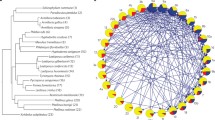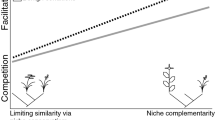Abstract
Plant communities are often structured by interactions among species, such as competition or facilitation. If competition is an important factor that controls the presence and absence of species within intact communities, then a competitive hierarchy, a ranked order from competitive dominant to competitive subordinate, should predict the composition of intact communities. We tested whether a competitive hierarchy derived from pairwise comparisons accurately predicts species abundances within a constructed polyculture community consisting of seven species common to old-field plant communities. We first conducted a pot experiment in field conditions wherein we grew the species in all possible combinations, then created a competitive hierarchy derived from both competitive effect and competitive response for each species. Concurrently, at the same site in native field soil, we constructed polycultures consisting of the same seven species and calculated an abundance hierarchy based on foliar cover, biomass, and an index of species performance. The competitive hierarchy was not concordant with the abundance hierarchy, indicating that simple pairwise comparisons may not account for other factors that influence the abundance of species within relatively complex communities.
Similar content being viewed by others
References
Aarssen LW (1988) ‘Pecking order’ of four plant species from pastures of different ages. Oikos 51:3–12
Bigelow SW, Canham CD (2002) Community organization of tree species along soil nutrient gradients in a northeastern USA forest. J Ecol 90:188–200
Callaway RM, Walker LR (1997) Competition and facilitation: a synthetic approach to interactions in plant communities. Ecology 78:1958–1965
Carino DA, Daehler CC (2002) Can inconspicuous legumes facilitate alien grass invasion? Partridge peas and fountain grass in Hawai’i. Ecography 25:33–41
Connell JH (1980) Diversity and the coevolution of competitors, or the ghost of competition past. Oikos 35:131–138
Connell JH (1983) On the prevalence and relative importance of interspecific competition: evidence from field experiments. Am Nat 122:661–696
Edwards NT, Norby RJ (1998) Belowground respiratory responses of sugar maple and red maple saplings to atmospheric CO2 enrichment and elevated air temperature. Plant Soil 206:85–97
Fowler N (1982) Competition and coexistence in a North Carolina grassland. III. Mixtures of component species. J Ecol 70:77–92
Goldberg DE, Barton AM (1992) Patterns and consequences of interspecific competition in natural communities: a review of field experiments with plants. Am Nat 139:771–801
Goldberg DE, Landa K (1991) Competitive effect and response: hierarchies and correlated traits in the early stages of competition. J Ecol 79:1013–1030
Goldberg DE, Rajaniemi T, Gurevitch J, et al (1999) Empirical approaches to quantifying interaction intensity: competition and facilitation along productivity gradients. Ecology 80:1118–1131
Grime JP (1977) Evidence for the existence of three primary strategies in plants and its relevance to ecological theory. Am Nat 111:1169–1194
Gurevitch J, Wilson P, Stone JL, et al (1990) Competition among old-field perennials at different levels of soil fertility and available space. J Ecol 78:727–744
Hacker SD, Bertness MD (1999) Experimental evidence for factors maintaining plant species diversity in a New England salt marsh. Ecology 80:2064–2073
Howard TG (2001) The relationship of total and per-gram rankings in competitive effect to the natural abundance of herbaceous perennials. J Ecol 89:110–117
Howard TG, Goldberg DE (2001) Competitive response hierarchies for germination, growth, and survival, and their influence on abundance. Ecology 82:979–990
Hunter AE, Aarssen AW (1988) Plants helping plants. BioScience 38:34–40
Huston MA, Smith TM (1987) Plant succession: life history and competition. Am Nat 130:168–198
Karez R (2003) Competitive ranks of three Fucus spp. (Phaeophyta) in laboratory experiments–testing of Keddy’s competitive hierarchy model. Helgol Mar Res 57:83–90
Kelly JM (1975) Dynamics of root biomass in two eastern Tennessee old-field communities. Am Midl Nat 94:54–61
Keddy PA (1990) Competitive hierarchies and centrifugal organization in plant communities. In: Grace JB, Tilman D (eds) Perspectives in plant competition. Academic Press, New York
Keddy PA (2001) Competition. Kluwer Academic Publishers, Dordrecht
Keddy PA, Nielsen K, Weiher K, et al (2002) Relative competitive performance of 63 species of terrestrial herbaceous plants. J Veg Sci 13:5–16
Keddy P, Shipley B (1989) Competitive hierarchies in herbaceous plant communities. Oikos 54:234–241
Keddy P, Wisheu I (1989) Ecology, biogeography, and conservation of coastal plain plants: some general principles from the study of Nova Scotian wetlands. Rhodora 91:72–94
Kendall MG, Gibbons JD (1990) Rank correlation methods, 5th edn. Charles Griffin, London
Levene H (1960) Robust tests for equality of variance. In: Olkin I (eds) Contributions to probability and statistics. Stanford University Press, Palo Alto
Lortie CJ, Brooker RW, Choler P, et al (2004) Rethinking plant community theory. Oikos 107:433–438
MacArthur R, Levins R (1967) The limiting similarity, convergence, and divergence of coexisting species. Am Nat 101:377–385
Miller TE, Werner PA (1987) Competitive effects and responses between plant species in a first-year old-field community. Ecology 68:1201–1210
Mitchley J, Grubb PJ (1986) Control of relative abundance of perennials in chalk grassland in southern England. I. Constancy of rank order and results of pot- and field-experiments on the role of interference. J Ecol 74:1139–1166
Moore RM, Williams JD (1983) Competition among weedy species: diallel experiments. Aust J Ag Res 34:119–131
Mueller-Dombois D, Ellenberg H (1974) Aims and methods of vegetation ecology. John Wiley and Sons, Toronto
Norby RJ, Wullschleger SD, Gunderson CA, et al (1999) Tree responses to rising CO2: implications for the future forest. Plant Cell Environ 22:683–714
Norrington-Davies J (1967) Diallel analysis of competition between grass species. J Ag Sci 71:223–231
Novoplansky A, Goldberg DE (2001) Effects of water pulsing on individual performance and competitive hierarchies in plants. J Veg Sci 12: 199–208
NRCS (2007) Plants Database. Natural Resources Conservation Service, United States Department of Agriculture. http://plants.usda.gov. Cited 06 March 2007
Pacala SW, Tilman D (1994) Limiting similarity in mechanistic and spatial models of plant competition in heterogeneous environments. Am Nat 143:222–257
Panetta FD, Randall RP (1993) Variation between Emex australis populations in seed dormancy/non-dormancy cycles. Aust J Ecol 18:275–280
Perkins TA, Holmes WR, Weltzin JF Competitive hierarchies in multi-species communities: new methods and an empirical test. J Veg Sci. In press
Richardson DM, Allsopp N, D’Antonio CM (2000) Plant invasions––the role of mutualisms. Biol Rev 75:65–93
SAS Institute (1999) SAS/STAT user’s guide. Version 9.1. SAS Institute, Cary, N.C
Schoener TW (1983) Field experiments on interspecific competition. Am Nat 122:240–285
Shapiro SS, Wilk MB (1965) An analysis of variance test for normality (complete samples). Biometrika 52:591–611
Shipley B, Keddy PA (1994) Evaluating the evidence for competitive hierarchies in plant communities. Oikos 69:340–345
Silvertown J, Dale P (1991) Competitive hierarchies and the structure of herbaceous plant communities. Oikos 61: 441–444
Soil Conservation Service (1967) Soil survey and laboratory data and descriptions for some soils of Tennessee. Soil survey investigations report no. 15, U.S. Dept. Agric., Soil Conservation Service and Tennessee Agricultural Experiment Station
Sokal RR, Rohlf FJ (1995) Biometry: the principles and practice of statistics in biological research, 3rd edn. W. H. Freeman, New York
Suding KN, Goldberg DE (2001) Do disturbances alter competitive hierarchies? Separating mechanisms of species compositional change. Ecology 82:2133–2149
Van der Putten WH, Mortimer SR, Hedlund K, et al (2000) Plant species diversity as a drive of early succession in abandoned fields: a multi-site approach. Oecologia 124:91–99
Wilson SD, Keddy PA (1986) Species competitive ability and position along a natural stress/disturbance gradient. Ecology 67:1236–1242
Zamfir M, Goldberg DE (2000) The effect of initial density on interactions between bryophytes at individual and community levels. J Ecol 88:243–255
Acknowledgments
Research was funded by a summer research grant from the Department of Ecology and Evolutionary Biology at the University of Tennessee and by the Office of Science (BER), U. S. Department of Energy Grant No. DE-FG02-02ER63366. The authors thank P. Allen, C. DeVan, M. Fitzpatrick, C. Iversen, K. Kennard, and L. Souza for their many hours washing roots and other field help and logistical support.
Author information
Authors and Affiliations
Corresponding author
Rights and permissions
About this article
Cite this article
Engel, E.C., Weltzin, J.F. Can community composition be predicted from pairwise species interactions?. Plant Ecol 195, 77–85 (2008). https://doi.org/10.1007/s11258-007-9300-2
Received:
Accepted:
Published:
Issue Date:
DOI: https://doi.org/10.1007/s11258-007-9300-2




